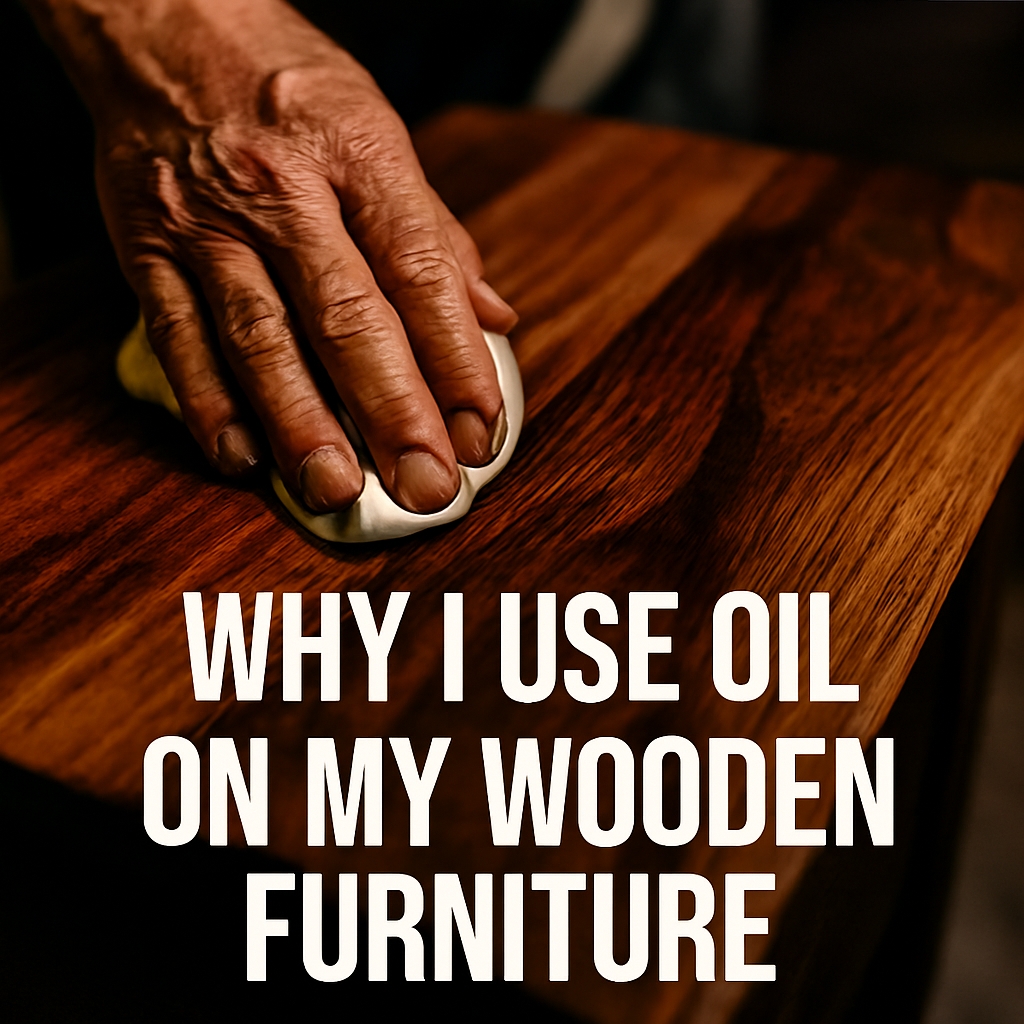Embracing The Natural Grain – Why I Use Oil On My Wooden Furniture
Honoring The Wood – Preserving Its Soul
Wood is a living material, even after it’s been shaped into furniture. I choose oil because it allows the grain to breathe and evolve over time. Unlike varnish or estapol, oil doesn’t trap the wood beneath a synthetic shell. It penetrates the fibers, enhancing the natural texture and tone. This method respects the organic origin of the material. I find that oil finishes deepen the emotional connection between object and space. The result is a surface that feels alive, not sealed off. It’s not just about aesthetics—it’s about honoring the wood’s story. Oil lets the furniture age gracefully, developing patina rather than peeling. That’s why I reach for oil when I want the wood to speak.Here is why I use oil on my wooden furniture.
| Finish Type | Surface Feel | Grain Visibility | Breathability | Aging Process |
|---|---|---|---|---|
| Oil | Warm and tactile | High | Yes | Patina develops |
| Estapol | Slick and hard | Medium | No | Can crack or peel |
| Varnish | Glossy and rigid | Low | No | May yellow over time |

Why I Use Oil On My Wooden Furniture Instead Of Estapol Or Varnish
Avoiding Surface Plasticity
Choosing Texture Over Gloss
Estapol and varnish create a barrier that feels artificial to the touch. I prefer the tactile honesty of oiled wood. It’s not just about how it looks—it’s about how it feels under your fingers. Glossy finishes can reflect light in ways that distort the wood’s natural depth. Oil, on the other hand, absorbs light and reveals subtle shifts in tone. This makes each piece feel more grounded and less manufactured. I want my furniture to invite interaction, not repel it with a plastic sheen. The texture of oiled wood is soft, warm, and responsive. It changes slightly with humidity and temperature, like skin. That responsiveness is part of its charm.
- Oil finishes preserve the wood’s natural texture
- Varnish and estapol create a synthetic surface layer
- Glossy coatings can feel cold and impersonal
- Oiled wood feels warm and organic
- Surface plasticity reduces tactile engagement
- Oil allows for subtle tonal shifts
- Varnish reflects light harshly
- Estapol can feel slippery or sterile
- Texture influences emotional connection
- Oiled surfaces invite touch and interaction
Repairing With Ease
Restoring Without Stripping
One of the most practical reasons I use oil is ease of maintenance. If a surface gets scratched or dull, I can simply reapply oil. There’s no need to sand back layers or strip the finish entirely. Varnish and estapol require more invasive repairs. They chip, crack, and flake in ways that demand full refinishing. Oil, by contrast, integrates into the wood and builds over time. This makes spot repairs seamless and stress-free. I value furniture that can evolve with use, not degrade under pressure. The ability to refresh without disruption is essential. It keeps the furniture functional and beautiful without major intervention. That’s a long-term win.
| Finish Type | Repair Method | Time Required | Tools Needed | Surface Impact |
|---|---|---|---|---|
| Oil | Reapply directly | Low | Cloth, oil | Minimal disruption |
| Estapol | Sand and refinish | High | Sander, estapol | Full surface redo |
| Varnish | Strip and recoat | High | Chemicals, brush | Potential damage |
Prioritizing Health And Safety
Breathing Easier Indoors
Oil finishes tend to be lower in volatile organic compounds. Many are plant-based and emit fewer fumes. Varnish and estapol often contain synthetic resins and solvents. These can off-gas for days or weeks, affecting indoor air quality. I’m sensitive to chemical smells and prefer a finish that doesn’t linger in the air. Oiled furniture feels safer in bedrooms, nurseries, and kitchens. It’s not just about the wood—it’s about the people around it. Choosing oil is part of a broader commitment to wellness. I want my home to feel clean, breathable, and grounded. That starts with the materials I use. Oil supports that vision.
- Oil finishes often contain fewer VOCs
- Plant-based oils are safer for indoor use
- Varnish and estapol may off-gas harmful fumes
- Indoor air quality matters in enclosed spaces
- Oiled furniture suits bedrooms and nurseries
- Chemical smells can linger with synthetic finishes
- Health-conscious choices start with materials
- Oil supports a breathable home environment
- Safety includes long-term exposure risks
- Natural finishes align with wellness goals
Celebrating Imperfection
Letting The Wood Age Gracefully
Oil doesn’t freeze wood in time—it lets it evolve. I love how oiled furniture develops character with use. Scratches become stories, not flaws. Varnish and estapol aim to preserve a showroom look. But I’m more interested in lived-in beauty. Oil allows for subtle shifts in tone, texture, and sheen. It embraces the imperfect and the personal. That’s especially important in handmade or heirloom pieces. I want my furniture to reflect life, not resist it. The finish should deepen with time, not degrade. Oil makes that possible.
| Finish Type | Aging Behavior | Patina Development | Scratch Visibility | Emotional Impact |
|---|---|---|---|---|
| Oil | Evolves naturally | High | Low | Personal and warm |
| Estapol | Cracks or peels | Low | High | Cold and detached |
| Varnish | Yellows or chips | Medium | Medium | Formal and rigid |
Enhancing Color Depth
Amplifying Tone Without Artificial Shine
Oil finishes enrich the natural color of wood without masking it. They penetrate the surface and bring out the underlying hues. This creates a depth that feels authentic rather than manufactured. Varnish and estapol often sit on top of the wood, creating a uniform gloss that flattens tonal variation. I prefer the way oil allows for subtle shifts in color depending on light and angle. It’s especially effective on richly grained woods like walnut, teak, or jarrah. The result is a finish that feels dimensional and alive. Oil doesn’t just coat—it collaborates with the wood. That partnership creates a more expressive surface. It’s a visual language I trust.
| Wood Type | Oil Finish Appearance | Varnish Appearance | Estapol Appearance | Color Depth |
|---|---|---|---|---|
| Walnut | Rich, warm, layered | Glossy, slightly muted | Glossy, uniform | High |
| Oak | Golden, textured | Pale, reflective | Bright, synthetic | Medium |
| Teak | Deep, earthy, vibrant | Yellowed over time | Amber-toned | High |
| Pine | Soft, honeyed | Light, shiny | Clear, plastic-like | Low |
Supporting Sustainable Practices
Choosing Renewable Over Synthetic
Many oil finishes are derived from natural sources. Linseed, tung, and hemp oils are biodegradable and renewable. In contrast, estapol and varnish are petroleum-based and harder to dispose of responsibly. I care about the lifecycle of the materials I use. Oil aligns with a more sustainable approach to furniture care. It’s not just about the finish—it’s about the footprint. When I oil my furniture, I’m participating in a slower, more thoughtful process. That matters in a world of fast consumption. I want my choices to reflect care, not convenience. Oil supports that intention. It’s a finish that respects both the wood and the world.
- Linseed and tung oils are plant-derived
- Natural oils are biodegradable and low-impact
- Varnish and estapol contain synthetic resins
- Petroleum-based finishes contribute to environmental waste
- Oil supports circular material practices
- Sustainable finishes reduce long-term harm
- Renewable sources align with ecological values
- Disposal of oil-soaked rags requires care but not chemical treatment
- Estapol and varnish often require chemical strippers
- Conscious finishing choices reflect broader sustainability goals
Allowing For Seasonal Movement
Flexing With The Climate
Wood expands and contracts with environmental and weather changes in humidity and temperature. Oil finishes accommodate this movement by remaining flexible. Varnish and estapol, being rigid, can crack under stress. I live in a climate with seasonal shifts, and I want my furniture to adapt. Oil allows the wood to breathe and shift without damage. This is especially important for joints, tabletops, and wide panels. A finish that moves with the wood prevents structural issues. It’s not just cosmetic—it’s architectural. I’ve seen varnished surfaces buckle or split in summer heat. Oiled surfaces, by contrast, remain stable and intact. That resilience is part of their appeal.
| Climate Condition | Oil Finish Response | Varnish Response | Estapol Response | Risk Of Damage |
|---|---|---|---|---|
| High Humidity | Absorbs and adjusts | May blister | Can peel | Low with oil |
| Dry Heat | Contracts naturally | May crack | Can yellow | Medium |
| Seasonal Shifts | Expands and contracts | May split | Can distort | High with varnish |
| Indoor Heating | Maintains integrity | May flake | Can harden | Low with oil |

Encouraging Hands-On Care
Building Ritual Into Maintenance
Oiling furniture is a tactile, intentional process. It invites you to engage with the object, not just observe it. I enjoy the ritual of applying oil—rubbing it in, watching the wood respond. It’s a form of stewardship, not just upkeep. Varnish and estapol are more passive once applied. They don’t invite interaction or renewal. With oil, maintenance becomes a relationship. You learn the grain, the texture, the personality of each piece. That intimacy deepens your connection to the furniture. It’s not just about preserving—it’s about participating. I value that kind of care. It turns furniture into a living companion.
- Oiling requires direct contact and attention
- Maintenance becomes a personal ritual
- Varnish and estapol discourage hands-on care
- Oil finishes invite regular engagement
- Furniture becomes a partner, not a product
- Ritual builds emotional connection
- Grain and texture become familiar over time
- Oiling teaches patience and observation
- Maintenance becomes meaningful, not mechanical
- Care reflects respect for craftsmanship
Reducing Visual Distraction
Letting Form And Function Lead
Glossy finishes can distract from the shape and design of furniture. They catch light and draw attention to surface rather than structure. Oil finishes are more subdued, allowing the form to speak. I want my furniture to be appreciated for its lines, proportions, and joinery. Oil supports that by minimizing glare and reflection. It’s especially important in spaces with natural light. Varnish and estapol can create hotspots or visual noise. Oil keeps the focus on the design itself. That’s essential in minimalist or architectural interiors. I use oil to highlight intention, not embellishment. It’s a finish that respects the maker’s vision.
| Finish Type | Light Reflection | Design Visibility | Visual Noise | Best Use Case |
|---|---|---|---|---|
| Oil | Low | High | Minimal | Architectural furniture |
| Varnish | High | Medium | Moderate | Decorative pieces |
| Estapol | Very high | Low | High | Mass-produced items |
Preserving Tactile Warmth
Feeling The Wood Beneath Your Hands
Oil finishes retain the natural warmth of wood. When you touch an oiled surface, you feel the grain, not a synthetic barrier. This tactile quality is essential in spaces meant for comfort and connection. Varnish and estapol create a hard shell that separates you from the material. I want my furniture to feel like wood, not plastic. That’s especially important for pieces like dining tables, armrests, and bed frames. The warmth of oiled wood contributes to a sense of intimacy. It’s a finish that invites touch, not just admiration. I value that physical relationship with my environment. Oil keeps it alive.
| Surface Type | Oil Finish Feel | Varnish Feel | Estapol Feel | Tactile Warmth |
|---|---|---|---|---|
| Dining Table | Soft, textured | Hard, slick | Glossy, cool | High |
| Bed Frame | Smooth, natural | Rigid, sealed | Reflective, sterile | High |
| Armrest | Responsive, warm | Plastic-like | Slippery | Medium |
| Bookshelf | Matte, subtle | Glossy, hard | Bright, synthetic | Low |
Avoiding Yellowing And Discoloration
Keeping The Tone True
Over time, varnish and estapol can yellow or discolor. This is especially noticeable on lighter woods like pine or ash. Oil finishes, by contrast, tend to deepen naturally without shifting hue. I want my furniture to age gracefully, not artificially. Discoloration can undermine the integrity of a design. It’s frustrating to see a pale wood turn amber or orange due to chemical finishes. Oil preserves the original tone while enhancing depth. That’s important for consistency across a room. I use oil to maintain visual harmony. It’s a finish that respects the wood’s natural palette.
- Varnish can yellow over time
- Estapol may shift color with UV exposure
- Oil deepens tone without distortion
- Light woods are especially vulnerable to discoloration
- Yellowing affects design cohesion
- Oil maintains original hue across years
- Chemical finishes react to light and heat
- Discoloration can feel artificial or dated
- Oil supports long-term aesthetic integrity
- Tone preservation matters in curated interiors
Highlighting Craftsmanship
Letting The Joinery Speak
Oil finishes reveal the details of craftsmanship. They don’t obscure joints, inlays, or hand-carved elements. Varnish and estapol can create a uniform gloss that hides subtle work. I want the artistry of the furniture to be visible. That includes dovetails, mortise-and-tenon joints, and hand-planed surfaces. Oil enhances these features without overwhelming them. It’s a finish that collaborates with the maker’s intent. I use oil to celebrate the labor behind the object. That’s especially important in custom or heirloom pieces. The finish should frame the work, not flatten it. Oil makes that possible.
| Craft Detail | Oil Finish Visibility | Varnish Visibility | Estapol Visibility | Artistic Emphasis |
|---|---|---|---|---|
| Dovetail Joint | Clear, defined | Slightly muted | Glossy, blurred | High |
| Inlay Work | Rich, dimensional | Reflective, flattened | Bright, distracting | Medium |
| Hand Planing | Textured, visible | Glossy, smoothed | Slick, obscured | High |
| Peg Joinery | Natural, integrated | Sealed, uniform | Plastic-like | Medium |
Minimizing Environmental Impact
Choosing Low-Toxicity Options
Many oil finishes are low in toxicity and safe for indoor use. They don’t require heavy ventilation or protective gear. Varnish and estapol, on the other hand, often contain solvents and resins that pose health risks. I prefer finishes that don’t compromise air quality or safety. That’s especially important in homes with children or pets. Oil finishes can be applied with minimal disruption. They don’t linger in the air or leave behind harsh residues. I want my furniture to be part of a healthy living space. Oil supports that goal. It’s a finish that aligns with environmental responsibility.
- Oil finishes often contain natural ingredients
- Low-VOC oils reduce indoor pollution
- Varnish and estapol may emit harmful fumes
- Application safety matters in residential settings
- Oil supports non-toxic home environments
- Children and pets benefit from safer finishes
- Ventilation requirements are minimal with oil
- Chemical finishes require masks and gloves
- Oil aligns with eco-conscious living
- Health and sustainability go hand in hand
Supporting Long-Term Value
Investing In Longevity
Oiled furniture retains its value over time. The finish can be refreshed without professional intervention. Varnish and estapol often require full refinishing, which adds cost and complexity. I want my furniture to be a long-term investment, not a short-term fix. Oil supports that by allowing for gradual renewal. It’s a finish that grows with the piece, not against it. That’s important for resale, inheritance, or archival purposes. I use oil to protect both the object and its story. Longevity isn’t just about durability—it’s about adaptability. Oil makes that possible.
| Finish Type | Maintenance Cost | Professional Help Needed | Longevity | Resale Appeal |
|---|---|---|---|---|
| Oil | Low | No | High | Strong |
| Varnish | Medium | Yes | Medium | Moderate |
| Estapol | High | Yes | Low | Limited |
Avoiding Brittle Build-Up
Preventing Cracks And Flakes
Over time, varnish and estapol can become brittle. They form a hard shell that doesn’t flex with the wood. This leads to cracking, flaking, and eventual failure of the finish. Oil, by contrast, remains supple and integrated. It doesn’t sit on top of the wood—it becomes part of it. That flexibility is crucial in high-use areas like tabletops and chairs. I’ve seen varnished surfaces chip away under pressure, revealing raw wood beneath. Oiled surfaces wear more evenly and can be easily refreshed. There’s no dramatic failure—just graceful aging. That’s a finish I can trust.
| Finish Type | Flexibility | Risk Of Cracking | Maintenance Frequency | Failure Mode |
|---|---|---|---|---|
| Oil | High | Low | As needed | Wears evenly |
| Varnish | Low | High | Every few years | Cracks, chips |
| Estapol | Very low | Very high | Difficult to repair | Peels, flakes |

Encouraging Material Honesty
Letting The Wood Be Wood
I believe in finishes that tell the truth. Oil doesn’t pretend to be something it’s not. It doesn’t add artificial gloss or color. It simply enhances what’s already there. That’s important in a world full of synthetic surfaces. I want my furniture to feel grounded and real. Varnish and estapol can create a sense of distance between user and material. Oil closes that gap. It’s a finish that respects the wood’s identity. I use oil because it doesn’t disguise—it reveals. That kind of honesty matters in design.
- Oil finishes are transparent and authentic
- Varnish can obscure natural grain
- Estapol adds artificial sheen
- Material honesty builds trust in design
- Oil supports minimalist and natural aesthetics
- Synthetic finishes create visual distance
- Oiled wood feels more connected to nature
- Transparency enhances appreciation of craftsmanship
- Honest materials age more gracefully
- Oil aligns with slow, intentional living
Reducing Static And Dust Attraction
Keeping Surfaces Cleaner
Glossy finishes tend to attract dust and static. This is especially true with estapol, which can build up a charge. Oiled surfaces, being matte and breathable, resist this effect. They stay cleaner longer and are easier to wipe down. That’s a practical advantage in high-traffic areas. I’ve noticed that oiled furniture requires less frequent dusting. It also doesn’t show smudges or fingerprints as easily. Varnish and estapol can highlight every speck of dust. Oil keeps things calm and low-maintenance. That’s a small but meaningful benefit. It makes daily life smoother.
| Finish Type | Dust Attraction | Static Buildup | Fingerprint Visibility | Cleaning Frequency |
|---|---|---|---|---|
| Oil | Low | Minimal | Low | Infrequent |
| Varnish | Medium | Moderate | High | Frequent |
| Estapol | High | High | Very high | Very frequent |
Supporting Local Craft Traditions
Honoring Heritage Techniques
Many traditional woodworking cultures use oil as their primary finish. From Japanese shou sugi ban to Scandinavian soap and oil treatments, these methods emphasize simplicity and longevity. I choose oil to align with those values. It connects my furniture to a broader lineage of care and craft. Varnish and estapol are more recent, industrial inventions. They prioritize efficiency over intimacy. Oil, by contrast, is slow and deliberate. It reflects a different relationship to time and material. I want my furniture to carry that heritage forward. Oil makes that possible.
- Oil finishing is rooted in global craft traditions
- Scandinavian and Japanese methods favor oil-based care
- Varnish and estapol emerged from industrial processes
- Traditional finishes emphasize longevity and repair
- Oil aligns with slow, intentional craftsmanship
- Heritage techniques value material integrity
- Oiling connects modern work to ancestral knowledge
- Cultural continuity adds meaning to design
- Oil supports hand-finishing and small-batch production
- Craft traditions prioritize care over convenience
Adapting To Diverse Wood Species
One Finish, Many Expressions
Oil is remarkably versatile across different wood types. It adapts to the density, grain, and porosity of each species. That makes it ideal for mixed-wood furniture or reclaimed materials. Varnish and estapol often require specific formulations for different woods. Oil simplifies the process while enhancing the unique qualities of each board. I’ve used oil on everything from silky maple to rugged ironbark. In each case, it brought out the best in the wood. That adaptability is part of its strength. I trust it to meet the material where it is.
| Wood Species | Oil Finish Result | Varnish Result | Estapol Result | Compatibility |
|---|---|---|---|---|
| Maple | Soft, glowing | Slightly dulled | Glossy, pale | High |
| Ironbark | Deep, rich | Overly dark | Amber-toned | High |
| Ash | Bright, textured | Yellowed | Reflective | Medium |
| Jarrah | Warm, complex | Flattened | Glossy, red-shift | High |
Avoiding Visual Uniformity
Celebrating Variation Across Pieces
Oil finishes allow each piece of wood to express its individuality. No two boards absorb oil in exactly the same way. This creates subtle variation in tone and texture that adds richness to a space. Varnish and estapol tend to create a uniform surface, flattening these differences. I want my furniture to feel like a collection of living materials, not mass-produced units. Oil supports that by enhancing contrast and character. It’s especially powerful in rooms with mixed wood tones. The finish becomes a unifying thread without erasing uniqueness. That balance is hard to achieve with synthetic coatings. Oil makes it effortless.
| Finish Type | Visual Variation | Surface Uniformity | Grain Contrast | Spatial Harmony |
|---|---|---|---|---|
| Oil | High | Low | Strong | Natural |
| Varnish | Medium | High | Moderate | Gloss-dominant |
| Estapol | Low | Very high | Minimal | Synthetic |
Supporting Emotional Durability
Creating Objects That Matter
I believe furniture should carry emotional weight. It should feel like part of your life, not just part of your décor. Oil finishes contribute to that by inviting care, memory, and presence. They age with you, recording the passage of time in subtle ways. Varnish and estapol aim to preserve perfection, but perfection is sterile. I want my furniture to reflect use, not resist it. Oil allows for that kind of intimacy. It’s a finish that welcomes stories of fingerprints, warmth, and wear. That’s how objects become meaningful. That’s how they last—not just physically, but emotionally.
- Oil finishes support emotional connection
- Aging becomes part of the object’s story
- Varnish resists change, oil embraces it
- Furniture becomes a companion, not a commodity
- Wear patterns reflect personal history
- Oil invites memory through touch and care
- Synthetic finishes discourage interaction
- Emotional durability outlasts surface perfection
- Oiled wood feels lived-in, not showroom-frozen
- Meaning grows through use, not preservation
Reducing Application Complexity
Finishing Without Industrial Tools
Applying oil is simple and accessible. It doesn’t require spray booths, respirators, or industrial-grade brushes. A clean cloth and a bit of patience are enough. That makes oil ideal for DIY projects and small workshops. Varnish and estapol demand more equipment and expertise. They’re less forgiving of mistakes and harder to control. I prefer a finish that empowers rather than intimidates. Oil lets me work at my own pace, with minimal waste. It’s a process I can do in my own space, without special ventilation. That autonomy matters. It keeps the craft close to home.
| Finish Type | Application Tools | Skill Level Needed | Ventilation Required | DIY-Friendly |
|---|---|---|---|---|
| Oil | Cloth, gloves | Beginner | Minimal | Very high |
| Varnish | Brush, mask | Intermediate | Moderate | Medium |
| Estapol | Spray gun, mask | Advanced | High | Low |

Aligning With Aesthetic Philosophy
Choosing Quiet Over Flash
My design philosophy leans toward restraint and resonance. I want materials to speak softly but clearly. Oil finishes support that by offering a matte, grounded presence. They don’t shout for attention—they invite it. Varnish and estapol shine very bright and can often dominate a room with their shine. I prefer a finish that complements rather than competes. Oil lets the form and function of the piece lead. It’s a quiet confidence that suits my spaces. There’s a humility to oiled wood that I admire. It doesn’t need to prove itself. It just is.
- Oil finishes align with minimalist aesthetics
- Matte surfaces reduce visual noise
- Varnish and estapol can overwhelm subtle design
- Quiet materials create calm environments
- Oil supports architectural and organic interiors
- Glossy finishes can feel performative
- Oiled wood blends rather than boasts
- Design integrity thrives in restraint
- Material honesty enhances spatial flow
- Oil reflects a philosophy of presence over polish
Creating A Living Archive
Letting Furniture Tell Its Story
Every time I oil a piece of furniture, I’m adding to its archive. The layers build slowly, each one a record of care. This cumulative process creates a finish that’s both protective and personal. Varnish and estapol are static—they don’t evolve. Oil is dynamic. It responds to time, touch, and environment. That responsiveness turns furniture into a living document. I want my home to feel like a place where stories accumulate. Oiled wood supports that narrative. It’s not just a surface—it’s a memory keeper. That’s why I choose oil. It helps furniture remember.
| Finish Type | Evolves Over Time | Records Use | Finish Layers | Narrative Quality |
|---|---|---|---|---|
| Oil | Yes | Yes | Builds gradually | High |
| Varnish | No | No | Static layer | Low |
| Estapol | No | No | Sealed coating | Very low |
Conclusion – A Finish That Reflects My Values
Choosing oil over estapol or varnish is more than a technical decision—it’s a philosophical one. It reflects how I want to live: with care, presence, and respect for materials. Oil finishes are tactile, breathable, and honest. They support sustainability, repairability, and emotional connection. They don’t freeze wood in time—they let it evolve. That matters in a world that often prioritizes perfection over presence. I want my furniture to feelorganic and yet alive, not boring. I want it to carry memory, not just shine. Oil makes that possible. It’s not just a finish—it’s a way of being in relationship with the things we live with. And that relationship, like the wood itself, deserves to breathe.
Join The Discussion – What Does Your Furniture Say About You
Do you oil your wooden furniture, or do you prefer synthetic finishes? What do you notice about how your furniture feels, smells, and ages? Have you ever restored a piece with oil and watched it come back to life?
#WoodFinishing #NaturalMaterials #FurnitureCare #OiledWood #SustainableDesign #CraftsmanshipMatters #MaterialHonesty #SlowLiving #DesignPhilosophy #EmotionalDurability #HomeWithHeart #TactileDesign #FurnitureRestoration #WoodworkingTraditions #FinishWithCare















Leave a Reply